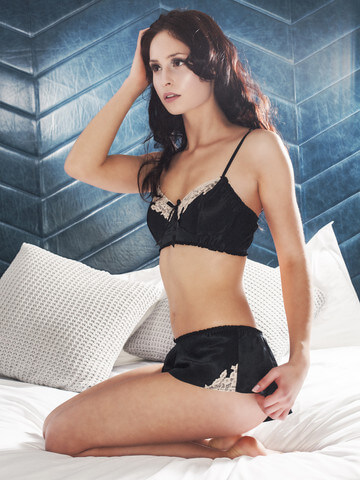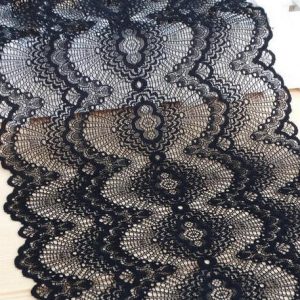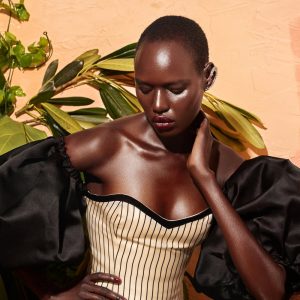Independent Designer Challenges: Colourful Lingerie
It goes without saying that independent designers face more challenges in the lingerie industry than the brands with massive corporations behind them. Some of these challenges will appear obvious even to people with no interest in lingerie (be that a matter of funding or public visibility). This series aims to peel back the curtains on some of the more hidden sides of the industry: this week I’m looking at why colours and underthings make such poor bedfellows in the world of independent design.
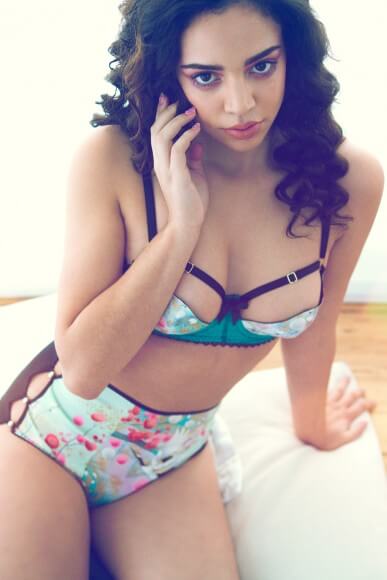
Using colour in lingerie brings a surprising amount of challenges with it: there's a reason that many independent designers avoid it.
Lingerie by Karolina Laskowska. Photo by Simon Crinks. Modelled by Yazzmin.
We’re used to seeing lingerie in almost every colour of the rainbow: come the Spring/Summer collections, lingerie boutiques are positively drowning in a plethora of hues. Colourful collections are just a matter of course for any big-name brand, but for an independent one it represents some serious investment and dedication. Especially if they’re making structured pieces like wired bras. Lingerie isn’t just about finding a single coloured outer fabric that you want to use…. Though even that can be prohibitively pricey: if we’re talking about a specialist lingerie fabric that has to be dyed to order, your minimum order could be hundreds if not thousands of metres. ‘Fashion’ colours are relatively risky investments (and rarely sell as well as their monochromatic counterparts) and it’s likely that exact colour would be repeated beyond a single season. This often makes ordering that fabric either unaffordable or a very poor investment.
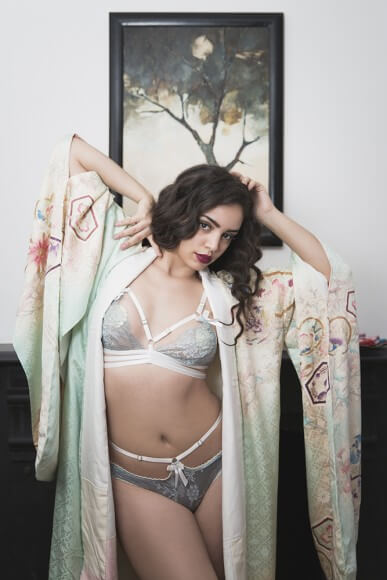
The lace in this set only has a minimum order of 5.4m, making this pop of colour much more accessible than if I wanted to use a more technical lingerie fabric.
Lingerie by Karolina Laskowska. Photography by Tigz Rice Studios. Modelled by Yazzmin
Fortunately, not all fabrics are faced with these order minimums. More expensive textiles such as silk and Leavers lace have much lower minimum orders, usually starting at around 5m. This is infinitely more achievable (though it’s worth pointing out that this only really applies to luxury lingerie brands, as these fabrics are always going to be relatively expensive) but a single fabric cannot be the be-all and end-all of a piece of lingerie. A wired bra is a complicated beast (ever wondered why so many new lingerie brands only make triangle bras?): even if it’s unpadded, the bare minimum of what you’ll need includes a non-stretch lining fabric, powernet for the wing, underband elastic, strap elastic, bra wire casing and hooks and eyes. Even knickers need elastics and cotton jersey gussets alongside the fashion fabric.
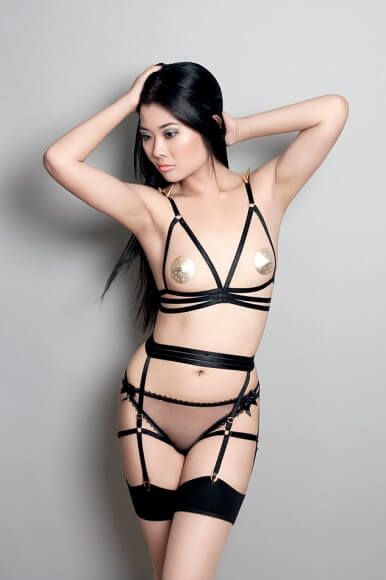
The only reason that I can afford the minimum order of 1000m of elastic is that almost all of my designs use it. As an estimate, most of my wired bras use at around 4m a piece.
Lingerie by Karolina Laskowska. Photography by Catherine Day. Modelled by Twig.
Most of these fabrics and components come from different suppliers and usually carry their own high minimum orders. Just as an example, my elastic supplier’s minimum order for a ‘stock’ elastic strapping in either black or white is 1000m. If you want this in a special order colour, this minimum order easily goes up by 10. That’s just for one type of elastic: most independent designers wouldn’t even touch that 1000m minimum, let alone the 10000m… and I can only justify it on the basis that almost all of my designs use it. This same principle applies to underband and leg elastics, wire casings and bone casings, hooks and eyes and rings and sliders. Lingerie has more individual components than almost every other type of clothing: although the finished garments tend to be smaller than mainline fashion, they're a whole lot more complicated.
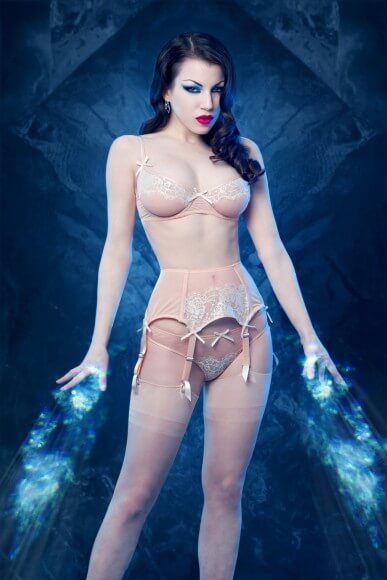
The 'Amelie' set by Kiss Me Deadly: dyeing all of the components for this set proved a logistical nightmare for the brand. Photography and modelling by Threnody in Velvet
When indie brands do decide to colour match, they don’t necessarily have to buy everything in ready colours: it’s possible to have all the necessary components dyed for them. Not that this is an easy way around the problem. Each fabric and trim has a different fabric composition and so either absorbs dye differently or needs different processes: getting everything to match is a process of trial and error that gets increasingly frustrating. Or in the words of Catherine Clavering from Kiss Me Deadly, ‘dyeing all the bits to match is impossible/extortionately expensive/irritating.’ A few years ago, her brand released a set called ‘Amelie’: a gorgeous bra set in a shade of soft peach. Her order was of 500 pieces, a relatively high volume for an independent brand, but there were still immense difficulties with the colour matching process: ‘we still had issues with the dye batch, we had bras with mismatched wings, bras that had spots… I can tell you we had to open up 500 peach bras and go through them with a fine tooth comb checking the wings matched!’ As in any business, time is money: having to individually go through each product is always going to be an issue that a designer wants to avoid.
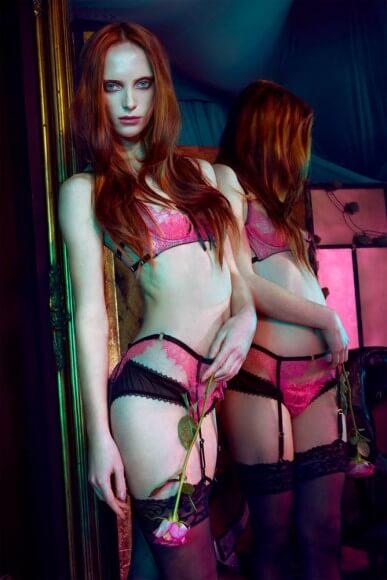
Every time I use a colourful fabric or lace it's paired with either black or white trims to avoid the headache of colour matching.
Lingerie by Karolina Laskowska. Photography by J Tuliniemi. Modelled by Maxine Anastasia
Of course, there are ways around these colour matching difficulties. When I decide to make colourful pieces (admittedly a rare occurrence), I pair them with contrasting trims in either black or white. I can admit that in many scenarios it may not be as elegant a finish as something fully colour matched, but it carries its own design charm. There's also the fact that black and white lingerie is just so much more popular in the grand scheme of things: monochrome sales will always outweigh colour sales, and monochrome lingerie is much easier to style into a wardrobe. I adore black and am firmly of the belief that lingerie doesn't need colour to be beautiful.
Of course, independent designers have one benefit that the larger brands don’t: they make much smaller quantities of product, which means they use smaller quantities of fabric. An excellent side effect of this is that indies are able to buy up the remnants from the big brands (which are often still in relatively large quantities), be that printed or colourful fashion fabrics or specifically matched trims. This has the benefit of not only reducing waste in the industry at large, but also gives the smaller designers a chance to play with fabrics and colours that they otherwise would never get the chance to use. Though upcycling isn’t just limited to the remnants of big brands: there are several lingerie brands that regularly use vintage laces and silks in quantities too small for a big name to even consider. The benefit of this? Small runs of lingerie that the customer knows is utterly unique and impossible to reproduce.
Readers: have you ever wondered why colourful lingerie can be so scarce on the independent design scene?What other issues would you like to learn about?



